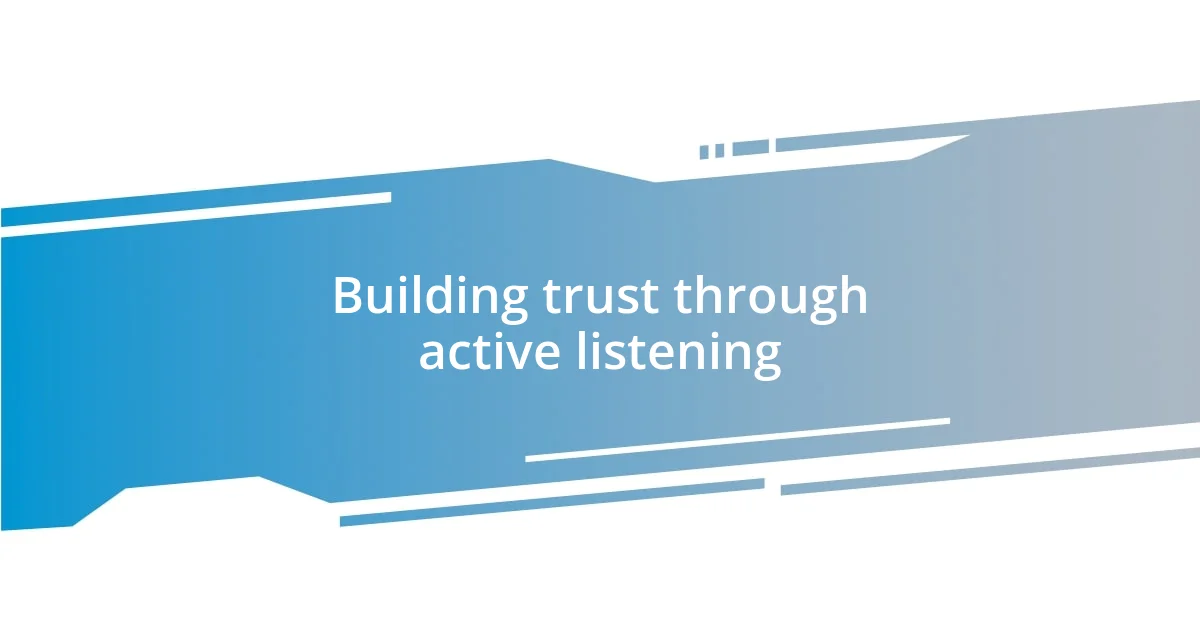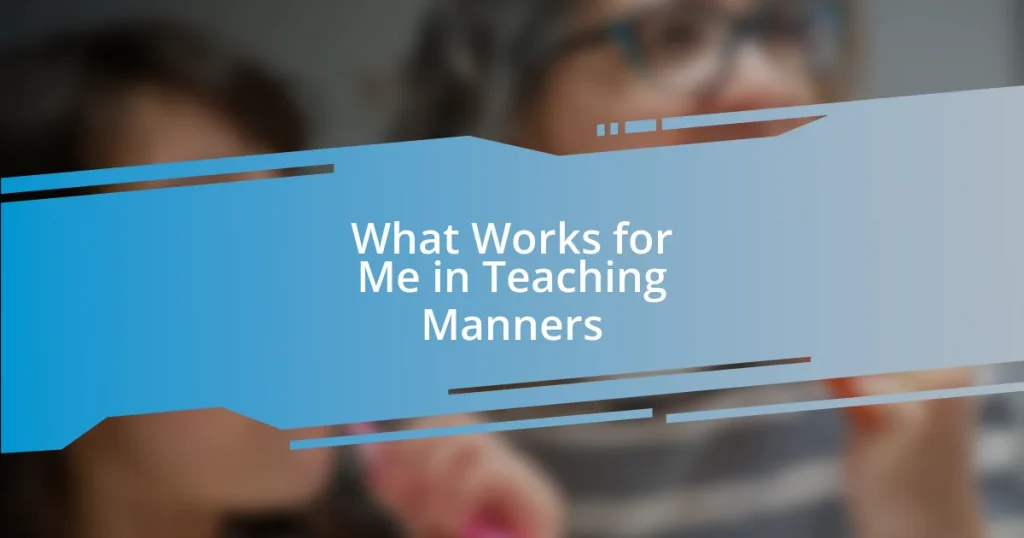Key takeaways:
- Understanding children’s emotions requires active listening and recognizing non-verbal cues, fostering a safe and supportive environment for expression.
- Using age-appropriate language enhances communication and engagement, adapting vocabulary and tone to match the child’s developmental stage.
- Encouraging open dialogue through questioning and validation strengthens trust and promotes deeper connections, while problem-solving techniques facilitate conflict resolution.

Understanding children’s communication needs
To truly understand children’s communication needs, it’s crucial to tap into their world. I remember the first time my niece expressed her frustration with words. She was around four years old, and instead of getting upset, I knelt down, looking her in the eye, and asked, “What’s making you sad right now?” Her face lit up as she began to share her feelings. This moment made it clear to me that sometimes, all they need is someone willing to listen and validate their emotions.
Children often don’t have the vocabulary to articulate their feelings, which makes non-verbal cues incredibly important. I’ve noticed that my son often uses gestures, like pointing or mimicking actions, when he struggles to find the right words. Have you ever observed a child who couldn’t express themselves and ended up frustrated? It’s moments like these that remind me that understanding goes beyond just hearing words—it’s about recognizing the entire message a child is trying to convey.
Moreover, it’s essential to create an environment where children feel safe to express themselves. I once facilitated a playgroup where we used puppets to discuss feelings. Watching the children open up through the puppets was transformative. They felt less vulnerable, and it reinforced for me how important it is to meet them at their level, using tools that resonate with them emotionally. What strategies have you found effective in bridging the gap between adult communication and a child’s understanding?

Building trust through active listening
When it comes to building trust through active listening, I find that my most profound connections happen when I truly focus on what a child is saying, both verbally and non-verbally. I recall sitting on the floor with my daughter, engaged in a deep talk about her day at school. She was animated, expressing her joys and worries, and all I did was lean in, nod, and provide affirmations. In those moments, I wasn’t just hearing her; I was showing her that her thoughts and feelings mattered. This investment in listening fosters a secure bond that allows her to share even the most delicate of topics without fear.
Active listening involves several key practices that I’ve found effective in nurturing trust:
– Eye contact: It shows that I’m present and genuinely interested.
– Open body language: I keep my arms uncrossed and lean slightly towards her to convey engagement.
– Mirroring emotions: By reflecting her feelings back, I reassure her that I understand.
– Avoiding interruption: I wait until she finishes her thoughts, which makes her feel valued.
– Asking questions: I probe deeper when appropriate, inviting her to explore her feelings further.
I’ve seen firsthand how these practices invite children to open up, emphasizing that their voices are not just heard but celebrated.

Using age-appropriate language
Using age-appropriate language is fundamental in fostering effective communication with children. I recall a time when I was reading a story to my nephew. He was five, and the book was filled with complex words. Instead of glossing over them, I took the time to explain each term in simple phrases. His eyes brightened with understanding, and he even eager to share his thoughts about the story. This made me realize how important it is to adapt my vocabulary to their level to hold their interest and promote engagement.
When communicating with kids, I always adjust my tone to match their developmental stage. For instance, using playful language with younger children can make learning seem like fun. I often find myself using silly phrases or sing-song tones that invite laughter and connection—I’ve seen kids respond to this with huge smiles. However, with older kids, I opt for more straightforward language, allowing space for deeper discussions. This flexibility helps bridge gaps and create relatable dialogues.
The challenge comes with knowing when to simplify and when to elevate our language. I’ve learned that asking open-ended questions can guide me in this process. For example, instead of asking, “Did you like school today?” I ask, “What made you excited at school today?” This not only opens up the conversation but encourages them to express themselves. It’s like shifting gears to match their pace, making communication smoother and more meaningful.
| Age Group | Language Use |
|---|---|
| Preschoolers (3-5 years) | Use simple words, engaging, playful tone, incorporate gestures. |
| Early Elementary (6-8 years) | Introduce age-appropriate vocabulary, use questions to encourage sharing. |
| Older Kids (9-12 years) | Utilize more complex sentences, maintain a straightforward approach fostering discussions. |

Non-verbal cues in kid communication
Kids communicate a lot through non-verbal cues, and I’ve learned to pay close attention to these signals. Once, during a quiet moment with my son, he was playing with his toys but kept glancing up at me. I realized his little fidgeting hands and slight frown meant he needed reassurance about something weighing on his mind. This taught me that even when they aren’t speaking, their body language can reveal so much, helping me understand what’s happening internally.
I can’t emphasize enough the impact of facial expressions in a child’s communication. For instance, one afternoon, I saw my daughter’s face light up when I praised her artwork. That sheer joy was unmistakable; it was as though her smile conveyed more than any words could express. I often wonder: Why do we sometimes ignore these beautiful surges of emotion? They offer invaluable insights into what they cherish or feel upset about, and I’ve found that acknowledging this can strengthen our bond.
Then there’s the magic of personal space and posture. I recall attending a school event and noticed a shy child standing with their back against the wall, arms crossed. It struck me that this closed-off stance was a clear sign of discomfort or anxiety. I’ve realized that gently inviting kids into a more open posture – perhaps through a warm smile or an approachable stance – can encourage them to share more freely. It’s all about creating an inviting atmosphere that respects their cues while promoting connection, don’t you think?

Encouraging open dialogue and questions
Encouraging kids to engage in open dialogue can transform our conversations. I remember a time when my daughter came home from school, bubbling with curiosity about her science project. I made sure to ask questions that went beyond “What did you learn?” Instead, I asked, “What parts of your project do you find the most exciting?” This sparked a lively discussion, allowing her to express her enthusiasm and creativity. I find that when we show genuine interest in their thoughts, it encourages them to share even more.
Creating a safe space for questions is crucial. I often make it a point to say, “There are no wrong questions here,” during our chats. The other day, my son hesitated before asking about why the sky is blue. As soon as I reassured him, he blossomed, explaining his thoughts before I could respond. It struck me how a little encouragement can open up a world of curiosity. I’ve learned that validating their instincts to question ignites a fire of learning and discovery.
I’ve come to see asking questions as a bridge in our conversations. The more I invite them to think critically, the more insightful our discussions become. For instance, during a recent car ride, I asked my son how he would solve a problem in one of his favorite games. The brilliance of his ideas opened my eyes—kids have such vivid imaginations! Engaging them in this way not only deepens our connection but also reveals just how capable they truly are, making it a wonderful exchange for both of us.

Techniques for resolving conflicts
When it comes to resolving conflicts, I’ve found that taking a moment to listen can make all the difference. Just the other day, I witnessed my son getting into a squabble with a friend. Instead of jumping in to mediate, I patiently gave them space, which allowed them to vocalize their feelings. This not only defused the situation but also empowered them to understand each other’s perspectives. What if we could all practice this kind of mindful listening a bit more in our daily interactions?
Another technique that has proven effective for me is the “I feel” statement. Once, during a tense moment between my daughter and me, I chose to express my feelings by saying, “I feel sad when we argue because I really love spending time with you.” This approach shifted the dynamic significantly, as it opened the door to a heartfelt conversation. I began to wonder: How often do we simply express our emotions rather than react defensively?
I also emphasize the importance of problem-solving together. One evening, my kids and I faced a disagreement about what game to play. Instead of imposing my choice, I facilitated a brainstorming session where everyone could offer suggestions. This collaborative approach not only resolved the conflict but also taught them valuable skills in teamwork and compromise. How rewarding it is to witness their growth as they learn to navigate conflict constructively!

Fostering a positive communication environment
Fostering a positive communication environment starts with creating trust. I remember one rainy afternoon when my son was upset about a difficult assignment. Instead of diving in with advice, I simply sat beside him and said, “I’m here if you want to talk.” It felt powerful when he eventually opened up about his frustrations. It made me realize that sometimes, just being present is the most supportive thing we can offer.
I also believe that celebrating small victories is vital. After a productive conversation with my daughter about her feelings, I made a point to acknowledge how proud I was of her for sharing her thoughts so openly. This simple act of recognition strengthened our bond and encouraged her to keep expressing herself. Have you noticed how positive reinforcement can create a ripple effect in communication? It’s fascinating how these small gestures can lead to deeper connections over time.
Moreover, I find that maintaining a playful atmosphere can foster openness. One day, while we were cooking together, I casually tossed in a silly question about the funniest thing that happened that week. The laughter that followed not only eased any tension but also led to a heartwarming discussion about our experiences. Who knew that a bit of laughter could pave the way for more meaningful conversations? It’s truly incredible how a joyful environment invites kids to share their thoughts and feelings without hesitation.
















